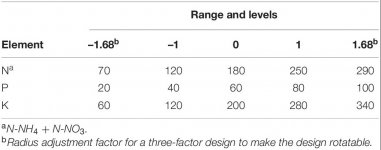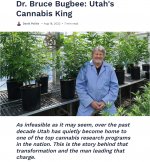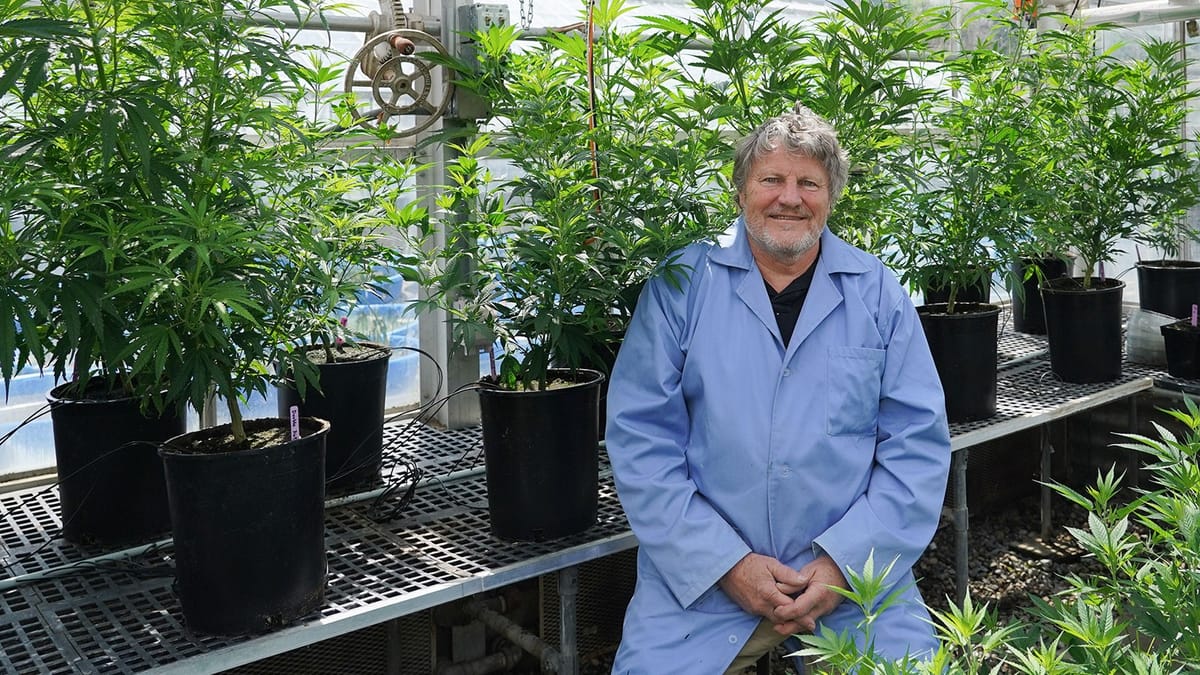Tomatoesonly
Active member
I think I might give that Bugbee formula a try. He seems like a dude that knows full well what he's looking for in a finished flower, even though they have to "destroy" it in the end.
I think I might give that Bugbee formula a try. He seems like a dude that knows full well what he's looking for in a finished flower, even though they have to "destroy" it in the end.
I'm trying those too. I've also compared them with the ones from NCSU: Bugbee goes slightly higher with K, but otherwise everything is in the range that you would expect based on the tissue analyses.I think I might give that Bugbee formula a try. He seems like a dude that knows full well what he's looking for in a finished flower, even though they have to "destroy" it in the end.
The objective of this study was to determine the optimal concentrations of NPK for the flowering stage of cannabis in a soilless production system using the RSM approach.
These results can provide guidance to cultivators when formulating nutrient solutions for soilless cannabis production and demonstrates the utility of surface response design for efficient multi-nutrient optimisation.


The effect of phosphorus on growth, development and
quality of Cannabis has been well studied over the recent years
(Aubin et al., 2015;Bernstein et al., 2019;Cockson et al., 2020;
Shiponi and Bernstein, 2021a;Shiponi and Bernstein, 2021b;
Veazie et al., 2021), but few studies have examined nutrient
partitioning between leaves and flowers and no studies have
quantified the waste associated with over-fertilization.
Our data indicate that a Psupply of 25mg per L in
continuous liquid feed was sufficient for maximum yield and
cannabinoid concentration. This is generally consistent with
Shiponi and Bernstein (2021b) who found no benefitofP
above 30 mg per L in one high-THC cultivar. In contrast,
Cockson et al. (2020) reported no additional benefit in yield or
cannabinoid concentration above about 11 mg P per L. This low
optimum for P could be caused by an increase in the volume of
irrigation, which would increase the total P delivered to the root-
zone. There could also be genetic variability in P requirements
among cultivars (Cong et al., 2020)
So, back on topic: I took another quick look at the study. It seems to me that mathematicians rather than botanists created the study.

To be honest I think most people overthink the nutrient sequence for cannabis. It doesn't take more than what's needed from Mother Nature. All those extra additives are just ways to get you to spend money.
Then you have done everything rightI have been preaching the need for using plenty of N during flowering to retain healthy productive leaves for decades on a dozen cannabis forums. Ironically, I just posted about hitting an indica with a 25-5-15 about 6 weeks into flowering.
It's only overthinking if it's linked to distress or is somehow consuming you with a negative effect. Anything else is just consideration. I don't see any good reason to tell someone they are thinking too much about there interests.
I have not seen that P paper from Bugbee.
I could be some time...

If you run hydro and mix your own nutrient solution from salts, you have to overthink the topic a little bit.
We are also only talking about nutrients here, not supplements
Am I correct in assuming that your question was actually directed at Ca++? You asked him about his analysis. What are you trying to achieve with that? A single analysis, as also found in your link, may not tell us much. They are primarily of interest to him personally when he has values to compare. We have such values in the article from the North Carolina State University, which calculated the average based on over 6000 samples (the methodology is explained).OK guys, I asked for tissue analysis info, here it is. https://overgrow.com/t/osmocote-my-favorite-plant-food-easy-peasy-complete/106332/80


Your plant looks great, no doubt about it. But do scientific studies not count as real-world results for you? I personally find them more reliable than anecdotal reports from individuals. In my opinion, there is nothing more real-world than scientific research. The guy grows real plants in the real worldI'm just asking for some real world results.

Am I correct in assuming that your question was actually directed at Ca++? You asked him about his analysis. What are you trying to achieve with that? A single analysis, as also found in your link, may not tell us much. They are primarily of interest to him personally when he has values to compare. We have such values in the article from the North Carolina State University, which calculated the average based on over 6000 samples (the methodology is explained).

Hemp Leaf Tissue Nutrient Ranges: Refinement of Reference Standards for Floral Hemp | NC State Extension Publications
As a newly legal crop, little information exists about optimum nutrient levels in hemp. This publication provides additional information on hemp leaf tissue nutrient ranges from a survey conducted between 2017 and 2020.content.ces.ncsu.edu
In general, if you want to read more about it, you can find additional links in Bugbee's paper.
View attachment 18842485

Principles of Nutrient and Water Management for Indoor Agriculture
Mass balance principles are a cornerstone of efficient fertilizer use and can be utilized to optimize plant nutrition without discarding or leaching solution. Here, we describe the maintenance of closed hydroponic and soilless substrate systems based on mass balance. Water removed by...www.mdpi.com
I already posted the links here, so you actually had enough to read. And from the phosphorus study, we also have precise leaf and flower tissue analyses.
And I still don't fully understand your objection regarding the bottles. You're using a pre-mixed fertilizer (which I also use to some extent). You probably mix it with tap water for calcium. That's certainly a simple and proven practice. However, as I mentioned before, it's not as straightforward if you want to be more precise, which, for me, is one of the major advantages of hydroponics. On the other hand, it's necessary when working with pure RO water, calcium nitrate, Epsom salt, and so on. Fortunately, there are also apps like HydroBuddy that can help you calculate the desired values using predefined fertilizers.
Your plant looks great, no doubt about it. But do scientific studies not count as real-world results for you? I personally find them more reliable than anecdotal reports from individuals. In my opinion, there is nothing more real-world than scientific research. The guy grows real plants in the real world
View attachment 18842487

Dr. Bruce Bugbee: Utah's Cannabis King
But today, due in great measure to passage of the Agriculture Improvement Act of 2018, Dr. Bugbee is not only the high priest of hydroponics, he has also become Utah’s de facto King of Cannabis.newsroom.siliconslopes.com
Not here to beat my chest, just give you a frame of reference - I'm 73, been gardening about every kind of plant material you can think of for about 50 years both on a home and a commercial field scale. I just don't need guides any more. I can understand for water culture you would, and that's OK.
I'm educated/experienced in plant nutrition and soil chemistry. So, I keep it easy peasy, play games with a few foods in my toolbox and grow a few cannabis plants now and then. My current focus is grafting world class tropical fruit varieties to selected rootstocks in RootBuilder bottomless pots. They have and are getting nothing more than Osmocote 15-9-12 and rainwater. Talking big trees kept pruned to about 12' tall.
Certainly, when it comes to soil or outdoor cultivation, this approach works wonderfully, no doubt about it. In such cases, precise ratios are less critical.Ca - I throw in a cup or two of gypsum in my tractor bucket when I bulk mix whatever I have on hand. It works.
I think we might be talking past each other here. All the studies we have indicate that you're right in this regard. PK boosters and N reduction are largely unnecessary or even counterproductive. Your fertilizer also looks similar to the end result I'm aiming for. N-P2O5-K2O, as seen on the right.P is one of the most abused macros of cannabis growers, but if it "produces bigger and better buds", then it must be great, eh? No, it's not. I'll repeat what I wrote in the Overgrow response to the tissue analysis:
Is that in NPK or N-P2O5-K2O? In any case, it's a lot of N and very little P, regardless of the values. Bugbee recommends a simple ratio of 2-1-2 (N-P2O5-K2O) in one of his videos.Based on Table 1 essentially the NPK is around 4 - 0.5 - 2
Backs up what I’ve been preaching for years, cannabis doesn’t need much P.
Uncle Ben
That's NPK. Point being, give the plant a balanced NPK (albeit low P) with a good micros package and you're good to go. Hard to beat Dyna-Gro as a one part solution. Used their products for over 20 years. I pretty much stick to their 9-3-6 Foliage Pro and use it on all kinds of stuff like a foliar spray additive for my vineyard. Great for a foliar spray for cannabis too, just be sure to add a surfactant like NIS, or you're wasting your time. For foliar go 1/2 tsp/gallon. Rainwater as the carrier being best.Alright, you have more than double my age and significantly more experience. I understand that I may be making things more complicated at the moment, but it's with the intention of simplifying them later on. If I find the right ratio, I could simply mix two stock solutions from my ingredients.
Certainly, when it comes to soil or outdoor cultivation, this approach works wonderfully, no doubt about it. In such cases, precise ratios are less critical.
I think we might be talking past each other here. All the studies we have indicate that you're right in this regard. PK boosters and N reduction are largely unnecessary or even counterproductive. Your fertilizer also looks similar to the end result I'm aiming for. N-P2O5-K2O, as seen on the right.
View attachment 18842778
Is that in NPK or N-P2O5-K2O? In any case, it's a lot of N and very little P, regardless of the values. Bugbee recommends a simple ratio of 2-1-2 (N-P2O5-K2O) in one of his videos.
PK boosters and N reduction are largely unnecessary or even counterproductive. Your fertilizer also looks similar to the end result I'm aiming for. N-P2O5-K2O, as seen on the right.
View attachment 18842778
Is that in NPK or N-P2O5-K2O? In any case, it's a lot of N and very little P, regardless of the values. Bugbee recommends a simple ratio of 2-1-2 (N-P2O5-K2O) in one of his videos.
In the paper Utah Hydroponic Solution, you can find direct values for cannabis. Those are the ones I referred to regarding the high K values.What are your Ca numbers? What you posted seems to be a bit on the heavy side if Bugbees ratios are used... From the link posted he's at ~100-12-117-19-60 ( NPK-Mg-Ca ) I couldn't tell if he actually did increase anything for flowering.
I have also come across such statements in forums, but I haven't found any scientific evidence to support them.Does the NPK need to differ depending on wide or narrow leaf? Some breeders suggest low N for narrow leaf during flower. Can a narrow leaf strain be more sensitive to higher N ?
That's NPK. Point being, give the plant a balanced NPK (albeit low P) with a good micros package and you're good to go. Hard to beat Dyna-Gro as a one part solution. Used their products for over 20 years. I pretty much stick to their 9-3-6 Foliage Pro and use it on all kinds of stuff like a foliar spray additive for my vineyard. Great for a foliar spray for cannabis too, just be sure to add a surfactant like NIS, or you're wasting your time. For foliar go 1/2 tsp/gallon. Rainwater as the carrier being best.
Here's the link. Damn good info here. https://overgrow.com/t/osmocote-my-favorite-plant-food-easy-peasy-complete/106332/100
Uncle Ben
In the paper Utah Hydroponic Solution, you can find direct values for cannabis. Those are the ones I referred to regarding the high K values.
View attachment 18843041

The values there are for a WUE (Water Use Efficiency) of 4 g L−1. Values above 3 are more suitable for elevated CO2 levels.What I took from that link is he used the Dicot for normal CO2 Cannabis, and that one above is for EXTRA CO2.. which he is a big proponent of. He has done interviews where he says CO2 is a 30% gain, I can't imagine he would recommend using his high CO2 formula when not growing in an enhanced atmosphere. Any thoughts?
The ratios do not change in that case, as can be seen in the table. Doubling the WUE simply results in double the amount of nutrients.2.2. Measuring Water Use Efficiency
The WUE multiplier is best determined after harvest of a crop by dividing the total dry biomass by the cumulative water added. As a starting point, we have found that the WUE can be reasonably estimated from the average ambient humidity and CO2. The lowest WUE values have occurred in our greenhouse at 400 ppm CO2 and 40% relative humidity and have been 3 g L−1; the highest values, with CO2 enrichment and 70% humidity, can approach 6 g L−1. Nutrient concentrations can initially be based between these two environments and refined with each subsequent crop.
Ok.. so his DICOT table and Cannabis table are NOT inter-related? Cannabis has very much its own nutrient schedule that does NOT mathematically match up with the DICOT table, is that right?The values there are for a WUE (Water Use Efficiency) of 4 g L−1. Values above 3 are more suitable for elevated CO2 levels.
The ratios do not change in that case, as can be seen in the table. Doubling the WUE simply results in double the amount of nutrients.
My 85% of the WUE 4 solution can also be referred to as WUE 3.4.
Yes, that's how I understand it. Monocot and Dicot are the general solutions and for canna they have a more specific one.Ok.. so his DICOT table and Cannabis table are NOT inter-related? Cannabis has very much its own nutrient schedule that does NOT mathematically match up with the DICOT table, is that right?
Exactly. You can also simply divide by 4 and then multiply by the desired value if you want to make it very simple.So what you're saying is if I do 75% of the WUE Cannabis table, I will get 3 gL-1 for Cannabis specifically?